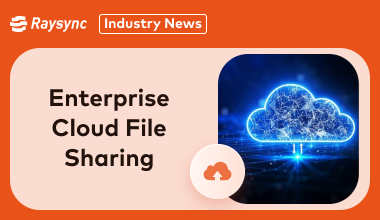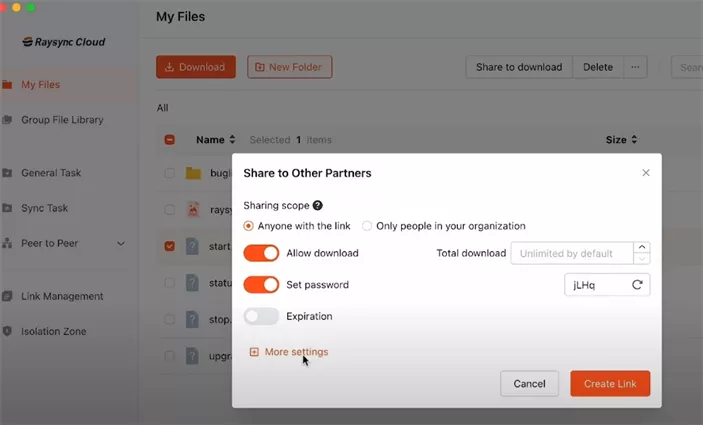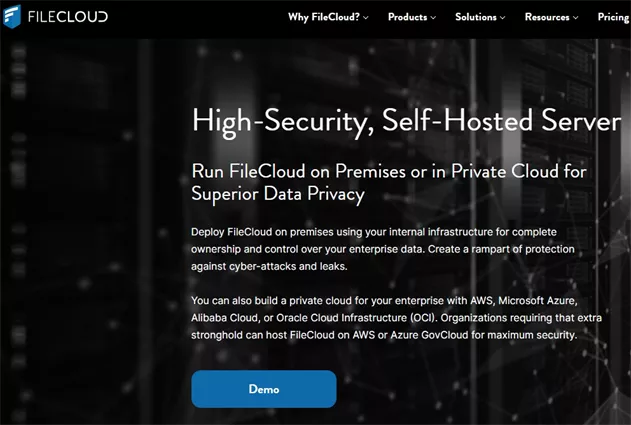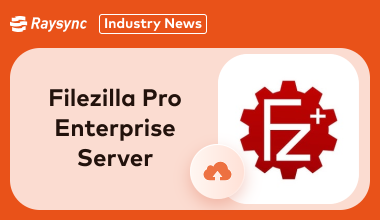Tutorial to Start Enterprise Cloud File Sharing
October 16, 2024Enterprise cloud file sharing offers a secure and efficient way to store, share, and sync files. It's a modern alternative to traditional methods like email attachments and USBs. With features like version control and advanced security, it's a valuable tool for businesses looking to streamline their workflows.
But how to start enterprise cloud file sharing and go about it? In this blog post we will dive into the world of cloud-powered collaboration and make your workflow smoother than ever!

What Is Enterprise Cloud File Sharing
Enterprise cloud file sharing is the secure storage, management, and sharing of data through cloud-based platforms designed specifically for businesses.
It allows employees, clients, and partners to access files remotely while ensuring that sensitive information is protected with solid security protocols like encryption and multi-factor authentication.
Unlike personal cloud storage (like Google Drive for individual use), enterprise cloud file sharing solutions offer compliance features to meet regulatory standards like HIPAA, GDPR, and SOC 2. They also come with administrative controls that let businesses manage access permissions, monitor usage, and maintain version history.
Top 5 Enterprise Cloud File Sharing Solutions
Let’s look at the top five top enterprise cloud file sharing platforms:
1. Raysync Cloud
Raysync Cloud is a high-performance enterprise cloud file sharing platform for enterprise-level sharing.

It specializes in large data transfers with ultra-fast speeds and advanced security protocols. With a focus on compliance and ease of use, Raysync ensures that businesses can manage, share, and sync files seamlessly across teams and regions. Raysync’s cloud infrastructure ensures files are available on demand, no matter where your team is located.
Its AES-256 encryption keeps data secure, while automatic syncing ensures that everyone always works on the latest version. Raysync also offers bandwidth optimization, making it a preferred tool for industries dealing with large datasets, such as media, finance, and healthcare.
Pros and Cons
Pros:
- High-speed file transfers, even for large datasets.
- AES-256 encryption ensures top-tier data security.
- Excellent compliance with regulations like GDPR.
- Supports large-scale remote collaboration across regions.
- Bandwidth control optimizes file transfers for efficiency.
Con:
- The advanced features might be too much for small businesses.
Pricing Model
Raysync offers flexible pricing models based on business size and data needs.
2. FileCloud
FileCloud provides a self-hosted cloud solution with complete control over data. Known for flexibility and security, it offers businesses the ability to set up cloud-sharing platforms on private servers or within public clouds like AWS. FileCloud is perfect for enterprises needing extensive customization while ensuring data security through encryption.

Pros and Cons
Pros:
- Self-hosting gives businesses full control over data.
- Works seamlessly with public cloud providers like AWS.
- Extensive customization options.
Cons:
- Can be complex to set up for non-technical users.
- Some features require additional licensing.
- Price may escalate with storage needs.
Pricing Model
Filecloud Enterprise Online:
|
Model |
Billing |
Min Users |
Offering |
Price |
|
Essentials |
Billed Annually. . |
Min 10 Users |
1 TB & 100 GB per Additional User |
$12.50 user/mo |
|
Advanced |
Billed Annually. |
Min 25 Users. |
2.5 TB & 100 GB per Additional User |
$18.75 user/mo |
|
Gov. Cloud |
Customized Plan |
Customized Plan |
1 TB & 100 GB per Additional User |
Custom Pricing |
3. Google Cloud
Google Cloud offers scalable enterprise cloud file sharing integrated with popular tools like Google Drive and Workspace. It’s an ideal solution for businesses already using Google’s ecosystem. With multi-layer security and AI-powered collaboration tools, Google Cloud ensures files are secure, accessible, and easy to manage.
Pros and Cons
Pros:
- Seamless integration with Google Workspace.
- Scalable storage and file-sharing options.
- AI tools for enhanced collaboration.
Cons:
- Some features require premium Workspace plans.
- Limited customization outside Google’s ecosystem.
- May be costly for large-scale storage needs.
Pricing Model
- Free Tier: 15 GB storage.
- Enterprise Plan: Custom pricing based on storage and tools.
4. One Drive
Microsoft’s OneDrive for business offers enterprise cloud file sharing focused on productivity and collaboration. It integrates seamlessly with Microsoft 365, allowing businesses to share files, manage workflows, and work on documents in real-time. With multi-factor authentication and encryption, OneDrive ensures your files are safe from unauthorized access.
Pros and Cons
Pros:
- Excellent integration with Microsoft 365 tools.
- Real-time collaboration on shared documents.
- Robust security features, including MFA.
Cons:
- Limited external collaboration without additional tools.
- Syncing large files can occasionally cause delays.
- Requires Microsoft 365 subscription for full features.
Pricing Model
- OneDrive Basic: Free with 5 GB storage.
- Microsoft 365 Business Basic: $6/month per user.
- Microsoft 365 Enterprise: Custom pricing.
5. MultCloud
MultCloud is a multi-cloud management solution that allows businesses to share, sync, and transfer files across multiple cloud services. It supports over 30+ cloud providers and offers advanced features like scheduled transfers and sync automation, making it ideal for businesses managing data across multiple platforms.
Pros and Cons
Pros:
- Supports over 30 cloud services for seamless integration.
- Scheduled transfers ensure automation.
- Free tier available with limited features.
Cons:
- Premium features require a subscription.
- No native storage option.
- Limited support for enterprise compliance.
Pricing Model
- 5 GB/Month: Free plan with limited features
- 1200 GB/Year: $59.99/billed annually.
- 2400 GB/Year: $99.98/billed annually.
FAQS about Enterprise Cloud File Sharing
Let’s look at the answers to some common questions about enterprise cloud file sharing:
1. What is the best file sharing platform?
Raysync stands out as one of the top contenders for the best enterprise cloud file sharing platform. Its focus on high-speed transfers, military-grade encryption, and compliance with international standards makes it ideal for businesses dealing with large volumes of sensitive data. It also supports auto-synchronization and bandwidth optimization, so your files are shared without delay.
2. What is the best way to share files in the cloud?
The most efficient way to share files in the cloud is by using a specialized platform like Raysync. Its advanced features like AES-256 encryption, multi-level permissions, and audit logs help businesses share files confidently, knowing their data is secure. Raysync also simplifies user management, so whether you’re sharing files with team members or external partners, you can assign roles and permissions with ease.
3. What is the difference between cloud storage and cloud sharing?
Cloud storage refers to the act of storing data in a remote server accessible via the internet, such as Google Drive or OneDrive. It focuses on keeping files safe and easily retrievable over time. On the other hand, cloud sharing emphasizes collaboration by allowing users to access, modify, and share files in real time.
The Bottom Line
For businesses prioritizing data safety, enterprise cloud file sharing is vital. Raysync Cloud provides fast, secure solutions with real-time syncing and user management. Choose it for effective collaboration and enhanced productivity.
You might also like
![Guide: How to Rsync Large File [Comprehensive Guide]](http://images.ctfassets.net/iz0mtfla8bmk/2T3uRocCaX8AfR3KrewAJD/7f5d3f58d05c156a41a6903d9ff6e366/rsync-large-file.png)
Industry news
February 7, 2025Need to Rsync huge files? This comprehensive guide simplifies the process, offering clear explanations and practical examples to help you master large file transfers with Rsync.
![Best 3 Tools for Secure P2P File Transfer [Priority to Security]](http://images.ctfassets.net/iz0mtfla8bmk/7l67cXNVgTWMLijr8H6AyG/9e324bd15df4a3f769accb487738fcf2/secure-p2p-file-transfer.png)
Industry news
September 27, 2024Prioritizing security and encryption, discover the best tools for secure p2p file transfer and learn how to ensure data protection.

Industry news
August 16, 2024Explore the ins and outs of FileZilla Pro Enterprise Server, from what it is to how to download it. Also discover top FileZilla alternatives like Raysync.